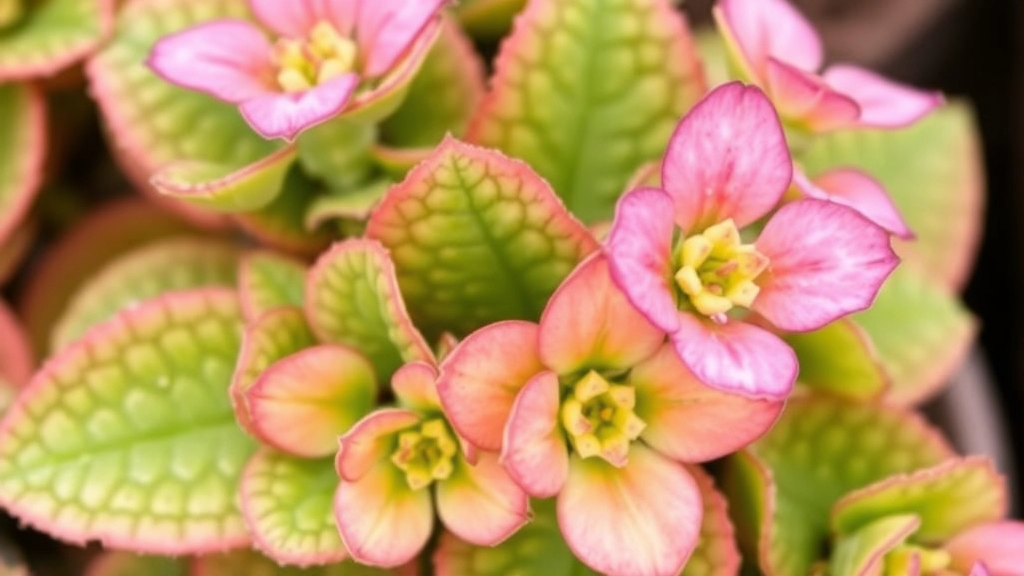Exploring the Fascinating World of Kalanchoe Plants
When it comes to exploring the fascinating world of Kalanchoe plants, there’s a variety for every garden and taste. From vibrant flowering species to low-maintenance succulents, Kalanchoe offers a unique charm to both indoor and outdoor spaces. In this guide, I’ll walk you through all types of Kalanchoe, highlighting their distinct features, growing conditions, and care tips to help you find the perfect match for your gardening needs.
Whether you’re drawn to the stunning blooms of flowering Kalanchoe or the intriguing textures of rare and unusual varieties, there’s something here for every plant enthusiast. We’ll also dive into fuzzy and velvety species ideal for indoor settings, and compact types perfect for small spaces. So, let’s get started and discover the diverse and captivating world of Kalanchoe plants!
Common Varieties of Kalanchoe Plants
Are you looking to add some vibrant greenery to your home or garden? Kalanchoe plants might just be the perfect solution.
These charming succulents come in various types, each with its own unique characteristics.
Popular Kalanchoe Varieties
- Kalanchoe blossfeldiana
- Known for its stunning clusters of small flowers.
- Typically blooms in vibrant shades of red, pink, yellow, and white.
- Ideal for indoor pots or as a gift.
- Kalanchoe tomentosa
- Commonly referred to as the “Panda Plant.”
- Features fuzzy, grey-green leaves with brown edges.
- A great choice for those who appreciate a unique texture.
- Kalanchoe luciae
- Often called the “Paddle Plant.”
- Its large, flat leaves resemble paddles and are often tinged with red.
- Adds a striking visual element to any space.
- Kalanchoe daigremontiana
- Known as the “Mother of Thousands.”
- Produces small plantlets along the edges of its leaves.
- A fascinating option for those who enjoy propagating plants.
- Kalanchoe beharensis
- Also known as the “Elephant Ear.”
- Features large, velvety leaves that can grow quite large.
- Perfect for creating a dramatic indoor display.
These common varieties of Kalanchoe are not just visually appealing; they also offer a range of care requirements, making them suitable for both novice and experienced gardeners alike.
Flowering Kalanchoe: Species Known for Stunning Blooms
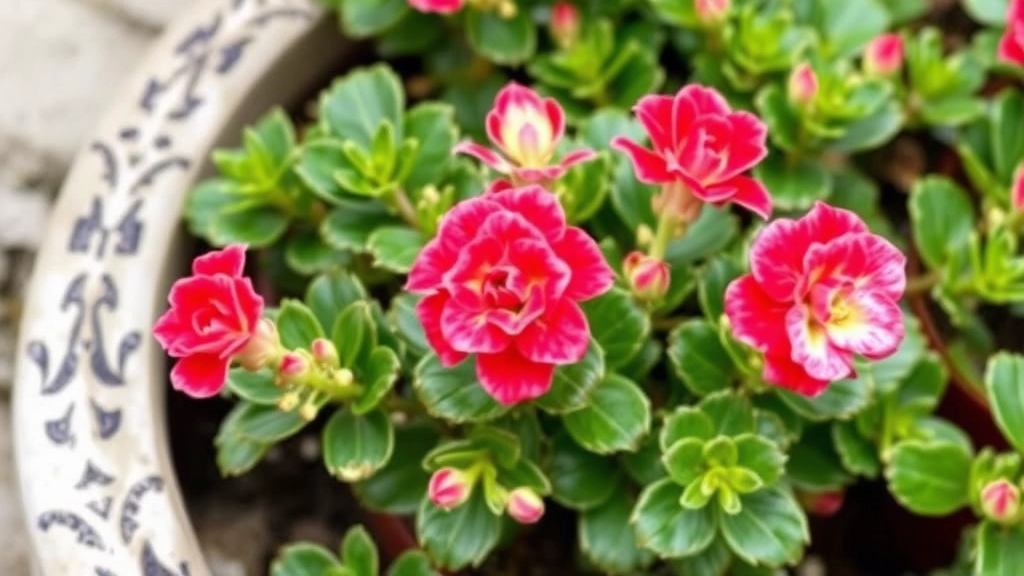
Have you ever walked into a garden and been captivated by vibrant flowers?
Kalanchoe plants are a true gem when it comes to stunning blooms.
These flowering beauties can brighten up any space and are surprisingly easy to care for.
Popular Flowering Kalanchoe Varieties
- Kalanchoe blossfeldiana
- This is the classic flowering Kalanchoe, known for its clusters of small, bright flowers.
- Blooms in various colours like red, pink, yellow, and white.
- Perfect for indoor pots or as a cheerful gift.
- Kalanchoe luciae (Paddle Plant)
- While known for its unique leaves, it also produces striking orange-red flowers.
- A great addition to any succulent collection.
- Kalanchoe thyrsiflora
- Also called ‘Flapjack’, this variety has thick, round leaves and tall flower spikes.
- The flowers are usually yellow, adding a pop of colour to your garden.
Why Choose Flowering Kalanchoe?
- Long Blooming Season: These plants often bloom multiple times a year.
- Low Maintenance: They thrive with minimal care, making them perfect for busy folks.
- Versatile: Great for pots, hanging baskets, or garden beds.
Care Tips for Flowering Kalanchoe
- Light: They love bright, indirect sunlight.
- Watering: Allow the soil to dry out between waterings.
- Fertiliser: A balanced fertiliser during the growing season can boost blooms.
Succulent and Low-Maintenance Kalanchoe Species
Are you tired of plants that demand constant attention?
Kalanchoe species stand out as some of the most succulent and low-maintenance options for both novice and seasoned gardeners.
These resilient plants offer a range of benefits, making them perfect for busy lifestyles.
Key Characteristics of Low-Maintenance Kalanchoe:
- Drought Tolerance: Kalanchoe plants store water in their leaves, allowing them to thrive with minimal watering.
- Adaptability: They can flourish in various light conditions, from bright indirect light to partial shade.
- Pest Resistance: These plants are less prone to common pests, reducing the need for frequent treatments.
Popular Low-Maintenance Varieties:
- Kalanchoe Blossfeldiana: Known for its vibrant flowers, it requires minimal care and can bloom multiple times a year.
- Kalanchoe Tomentosa: This variety features fuzzy leaves and is exceptionally forgiving when it comes to watering schedules.
- Kalanchoe Luciae: Often called the “Paddle Plant,” its thick leaves store water efficiently, making it an ideal choice for forgetful gardeners.
Care Tips:
- Watering: Allow the soil to dry out completely between waterings. Overwatering can lead to root rot.
- Soil: Use a well-draining succulent mix to prevent water retention.
- Fertilisation: A light feed during the growing season is sufficient; too much can harm the plant.
Rare and Unusual Kalanchoe Varieties
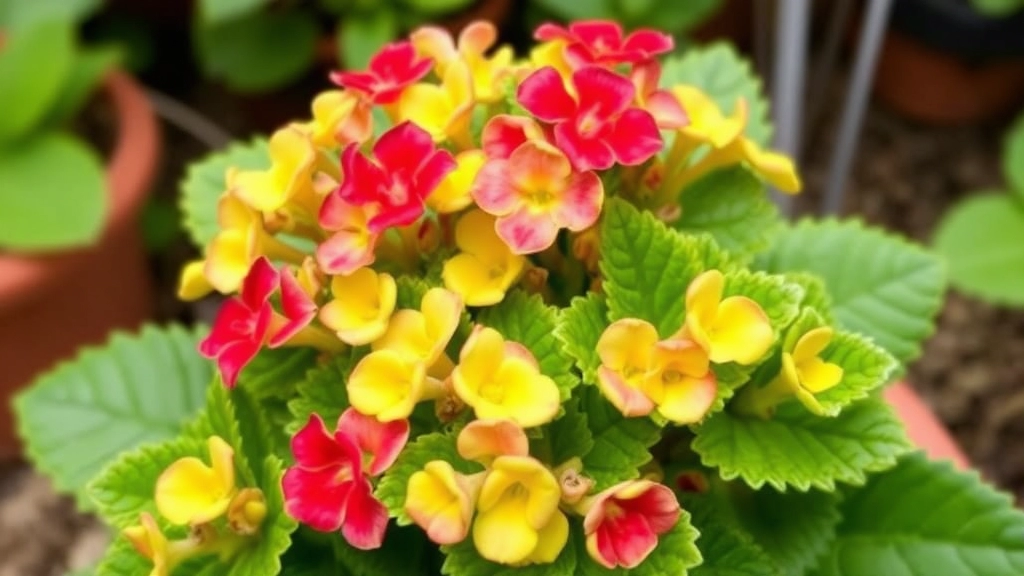
As we explore the fascinating world of Kalanchoe plants, it’s time to delve into the rare and unusual varieties that can truly elevate your collection.
Are you looking for something distinct to set your indoor or outdoor garden apart?
Rare Kalanchoe species often come with unique characteristics that make them stand out. Here are a few noteworthy options:
- Kalanchoe marmorata
Known as the “Panda Plant,” this variety features striking mottled leaves that resemble a work of art. The leaves are thick and fleshy, making them a robust choice for any succulent lover. - Kalanchoe tomentosa
Often referred to as “Felt Plant,” this species has soft, fuzzy leaves that are a delight to touch. Its unique texture adds an interesting dimension to any plant arrangement. - Kalanchoe beharensis
This variety, known as the “Elephant Ear,” boasts large, paddle-like leaves that can grow quite large. Its unusual shape and size make it a focal point in any garden. - Kalanchoe luciae
Commonly known as “Flapjack,” this succulent features stunning, flat leaves that turn a vibrant red when exposed to sunlight. Its striking appearance can transform any space. - Kalanchoe ‘Fang’
This hybrid showcases spiky, serrated edges on its leaves, giving it a fierce yet beautiful look. It’s a conversation starter for sure!
Why Choose Rare Kalanchoe Varieties?
- Aesthetic Appeal: Their unique shapes and colours can enhance your garden’s visual interest.
- Collectibility: Rare varieties often become treasured pieces in a plant enthusiast’s collection.
- Conversation Starters: Showcasing unusual plants can spark discussions among fellow gardeners.
Fuzzy and Velvety Kalanchoe Types for Indoor Gardens
When it comes to adding texture and warmth to your indoor garden, fuzzy and velvety Kalanchoe types are a fantastic choice.
Why Choose Fuzzy and Velvety Kalanchoe?
These plants not only stand out visually but also offer a unique tactile experience. Their soft, fuzzy leaves can make a space feel more inviting and lush.
Popular Varieties to Consider
- Kalanchoe tomentosa
Commonly known as the “Panda Plant.”
Features thick, fuzzy leaves with distinctive brown edges.
Ideal for bright, indirect light. For more detailed care instructions, check out our Kalanchoe Panda Plant Care Guide. - Kalanchoe beharensis
Often referred to as “Elephant Ear.”
Boasts large, velvety leaves that can grow quite large.
Thrives in well-drained soil and moderate light. Learn more in our Kalanchoe Beharensis Care Guide. - Kalanchoe luciae
Known as “Paddle Plant” or “Flapjacks.”
Has flat, paddle-shaped leaves with a soft texture.
Prefers full sun to maintain vibrant colours.
Care Tips for Fuzzy and Velvety Kalanchoe
- Light Requirements: Ensure they receive bright, indirect sunlight to prevent leaf burn.
- Watering: Allow the soil to dry out completely between waterings; overwatering can lead to root rot.
- Humidity: These plants thrive in moderate humidity but can tolerate drier conditions.
Why They’re Perfect for Indoor Spaces
Fuzzy and velvety Kalanchoe types are not just visually appealing; they are also low-maintenance. Their unique textures make them a conversation starter, and they can thrive in various indoor settings, from bright windowsills to office desks.
Kalanchoe Varieties Ideal for Outdoor Gardens
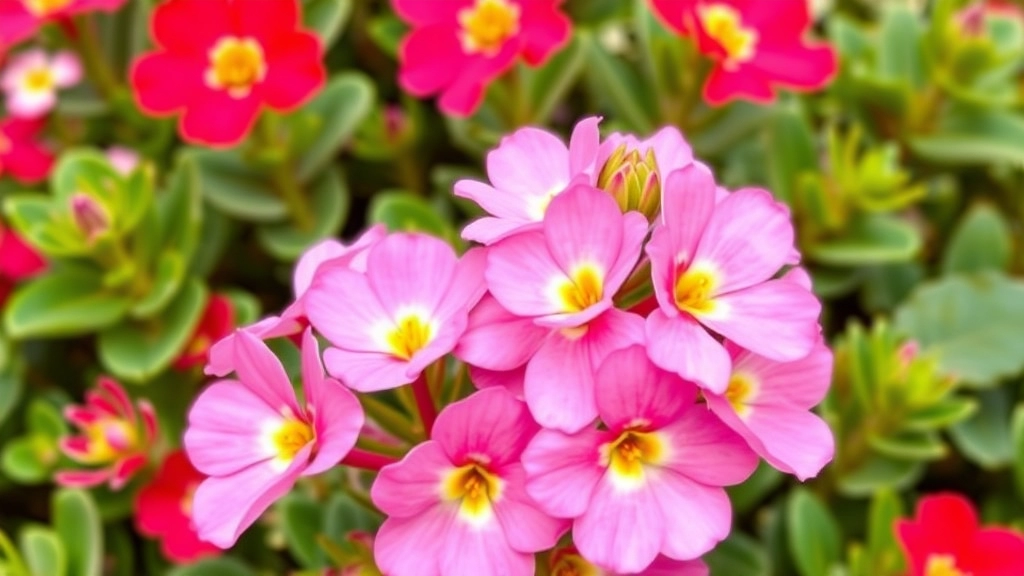
So, you’re thinking of adding some Kalanchoe to your outdoor space? Great choice! These plants can really brighten up your garden. But which varieties are best suited for the great outdoors? Let’s dive in!
Why Choose Kalanchoe for Your Garden?
Kalanchoe plants are not just pretty faces; they’re tough too! They thrive in warm, sunny spots and can handle a bit of neglect. Perfect for those of us who might forget to water every now and then.
Best Outdoor Kalanchoe Varieties
Here are some fabulous Kalanchoe varieties that will flourish outside:
- Kalanchoe blossfeldiana: This classic beauty is known for its vibrant flowers. It loves full sun and can bloom all year round with the right care.
- Kalanchoe luciae (Paddle Plant): With its unique paddle-shaped leaves, this one’s a showstopper. It prefers well-drained soil and can handle some drought.
- Kalanchoe tomentosa (Panda Plant): This variety has fuzzy, velvety leaves that give it a unique texture. It’s perfect for adding a different look to your garden.
- Kalanchoe beharensis (Elephant Bush): This one grows tall and bushy, making it a great focal point. It’s also quite drought-tolerant!
Tips for Planting Kalanchoe Outdoors
- Sunlight: Make sure they get at least 6 hours of sunlight daily.
- Soil: Use well-draining soil. Kalanchoe hates sitting in water!
- Watering: Water deeply but infrequently. Let the soil dry out between waterings.
- Spacing: Give them room to breathe. They can get bushy, so space them out accordingly.
A Quick Story
I once planted Kalanchoe blossfeldiana in my garden, and it turned into a riot of colours! Neighbours kept asking what my secret was. Just good soil and a sunny spot. Simple as that!
Paddle-Shaped Kalanchoe Species: Aesthetic Appeal
Have you ever wondered how to add a unique touch to your indoor or outdoor garden? Paddle-shaped Kalanchoe species may be the answer you’re looking for.
These striking plants, often characterised by their thick, flat leaves resembling a paddle, not only bring a sense of freshness but also serve as a conversation starter. Their unique shapes and vibrant colours can elevate any garden space, making them a favourite among succulent enthusiasts.
Key Paddle-Shaped Kalanchoe Varieties
- Kalanchoe luciae: Also known as the ‘Paddle Plant’, this variety boasts stunning red edges on its leaves, creating a dramatic visual contrast.
- Kalanchoe thyrsiflora: Commonly referred to as ‘Flapjack’, its large, round leaves stack beautifully, resembling a tiered cake.
- Kalanchoe beharensis: Known as ‘Elephant Ear’, this species features broad, velvety leaves that add texture and depth to your plant collection. For more detailed care instructions, check out our Elephant Ear Kalanchoe care guide.
Why Choose Paddle-Shaped Kalanchoe?
- Aesthetic Appeal: Their unique shapes and colours can enhance the visual interest of any garden.
- Low Maintenance: Like many Kalanchoe species, they require minimal care, making them perfect for busy plant lovers. Discover more about Kalanchoe plant care to keep your plants thriving.
- Versatile: Suitable for both indoor and outdoor settings, they adapt well to various environments.
Incorporating paddle-shaped Kalanchoe into your garden not only beautifies your space but also provides an easy-care option for plant enthusiasts.
Compact and Hanging Kalanchoe Varieties for Small Spaces
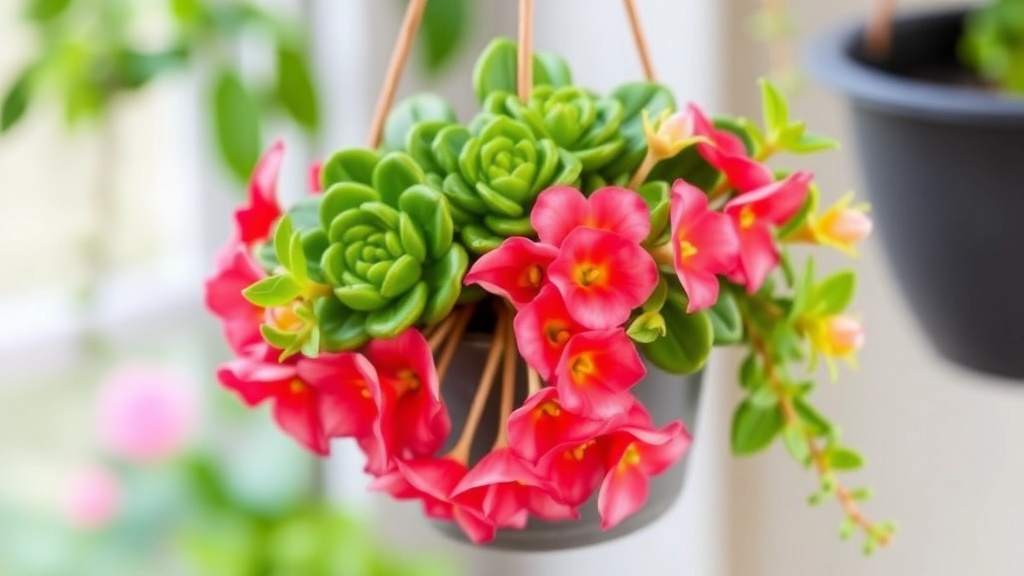
Are you struggling to find the right plants for your compact living space?
Kalanchoe offers some amazing options that fit perfectly into tight corners and small rooms.
These plants not only look great but also bring a touch of greenery into your home without taking up too much space.
Best Compact Kalanchoe Varieties
- Kalanchoe Blossfeldiana
– Known for its vibrant flowers.
– Grows to about 30 cm tall.
– Perfect for windowsills or small tables. - Kalanchoe Tomentosa (Panda Plant)
– Features soft, fuzzy leaves.
– Stays compact at around 30-40 cm.
– Great for adding texture to your collection. - Kalanchoe Luciae (Paddle Plant)
– Flat, paddle-shaped leaves.
– Grows up to 45 cm, but stays neat and tidy.
– A real eye-catcher in any small space.
Hanging Kalanchoe Varieties
If you’re looking to add some drama, hanging Kalanchoe varieties are a fantastic choice.
- Kalanchoe Marnieriana (Chandelier Plant)
– Cascading leaves that look stunning in a hanging pot.
– Grows well in bright, indirect light.
– A unique addition to your indoor garden. - Kalanchoe Beharensis (Mother of Thousands)
– Produces offsets that can spill over the pot.
– Thrives in hanging baskets.
– Adds a wild, natural look to your decor.
Tips for Success
- Light: Most Kalanchoe love bright, indirect sunlight.
- Watering: Let the soil dry out between waterings.
- Soil: Use a well-draining succulent mix.
Fast-Growing Kalanchoe Types for Quick Results
Are you eager to add vibrant greenery to your space but lack the patience for slow-growing plants? Fast-growing Kalanchoe varieties can be your go-to solution for instant gratification in your indoor or outdoor garden.
Why Choose Fast-Growing Kalanchoe?
Fast-growing Kalanchoe not only enhances your environment quickly but also provides a sense of accomplishment. Here are some compelling reasons to opt for these speedy growers:
- Quick Establishment: You’ll see results in a matter of weeks.
- Low Maintenance: Once established, they require minimal care.
- Versatile Use: Perfect for both indoor pots and outdoor gardens.
Top Fast-Growing Kalanchoe Varieties
- Kalanchoe blossfeldiana
- Known for its stunning clusters of flowers.
- Blooms in various colours, adding vibrancy to your space.
- Can grow up to 30 cm in height within a few months.
- Kalanchoe tomentosa (Panda Plant)
- Features fuzzy leaves that are both unique and attractive.
- Grows quickly, making it a favourite for indoor gardens.
- Ideal for beginners due to its resilience.
- Kalanchoe luciae (Paddle Plant)
- Recognised for its paddle-shaped leaves.
- Grows rapidly and can thrive in various conditions.
- Adds a striking aesthetic to any garden.
Care Tips for Fast Growth
To maximise the growth potential of your Kalanchoe, consider these simple care tips:
- Sunlight: Ensure they receive bright, indirect sunlight for optimal growth.
- Watering: Water only when the soil is dry to prevent root rot.
- Fertilisers: Use a balanced fertiliser during the growing season to boost growth.
Kalanchoe Species with Unique Leaf Patterns and Textures
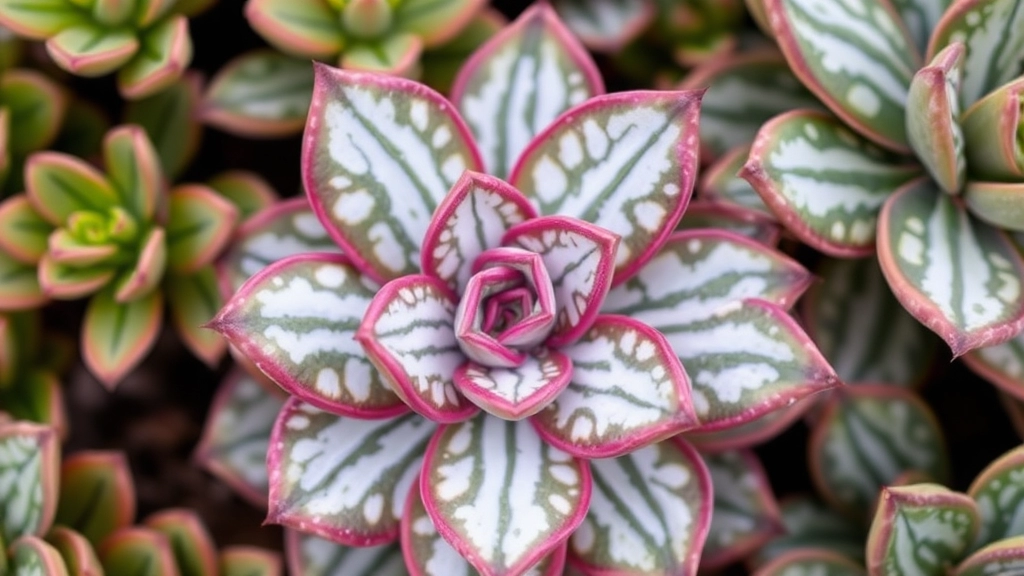
Have you ever found yourself mesmerised by the stunning variety of leaf patterns and textures in Kalanchoe plants?
These beauties offer more than just vibrant blooms; their foliage can be a real showstopper.
Let’s dive into some of the most captivating Kalanchoe species that flaunt unique leaves, making them perfect for any indoor or outdoor garden.
1. Kalanchoe luciae (Paddle Plant)
- Leaf Shape: Thick, paddle-like leaves that can grow quite large.
- Texture: Smooth and waxy, giving them a striking appearance.
- Colour: Often displays a lovely red edge, especially in bright light.
2. Kalanchoe tomentosa (Panda Plant)
- Leaf Shape: Small, rounded leaves that resemble panda ears.
- Texture: Fuzzy and velvety, thanks to the fine hairs covering the leaves.
- Colour: Grey-green with brownish tips, adding to its charm.
3. Kalanchoe beharensis (Felt Plant)
- Leaf Shape: Large, elongated leaves that can grow up to a foot long.
- Texture: Covered in a soft, felt-like coating that feels unique to the touch.
- Colour: A muted green with a hint of silver, making it an eye-catcher.
4. Kalanchoe marmorata (Pencil Plant)
- Leaf Shape: Long, narrow leaves that can resemble a pencil.
- Texture: Smooth with a glossy finish.
- Colour: Green with striking purple speckles, creating a marbled effect.
5. Kalanchoe ‘Fang’
- Leaf Shape: Thick, serrated leaves that have a dramatic look.
- Texture: Firm and fleshy, perfect for those who love a robust plant.
- Colour: Bright green with a hint of red on the edges.
These Kalanchoe species not only add visual interest but also provide a tactile experience that can elevate your gardening game.
Tips for Growing and Caring for Different Kalanchoe Varieties
As we explore the diverse world of Kalanchoe plants, it’s essential to understand how to keep these beauties thriving. Many enthusiasts often wonder how to provide the best care for their Kalanchoe varieties.
General Care Tips
- Light Requirements: Most Kalanchoe thrive in bright, indirect sunlight.
- Watering: Allow the soil to dry out between waterings. Overwatering can lead to root rot.
- Soil Type: Use a well-draining potting mix, ideally formulated for succulents.
- Temperature: Kalanchoe prefer warmer temperatures, ideally between 15°C to 25°C.
- Fertilisation: Feed with a diluted succulent fertiliser during the growing season (spring and summer).
Specific Care for Flowering Kalanchoe
- Pruning: After flowering, trim back spent blooms to promote new growth.
- Humidity: Keep humidity levels low; flowering Kalanchoe prefer drier conditions.
Succulent and Low-Maintenance Varieties
- Minimal Care: These varieties are perfect for beginners. Just ensure they have proper drainage and light.
- Repotting: Repot every couple of years to refresh the soil and provide room for growth.
Rare and Unusual Varieties
- Special Attention: Rare Kalanchoe may require specific care based on their native habitats. Research individual needs.
- Pest Control: Monitor for pests more frequently, as rare varieties can be more sensitive.
Fuzzy and Velvety Types
- Gentle Handling: Fuzzy leaves can be sensitive. Avoid excess moisture on the leaves to prevent fungal issues.
- Air Circulation: Ensure good airflow around these plants to avoid mildew.
Outdoor Kalanchoe Care
- Sun Exposure: Place outdoor varieties in a location that receives ample sunlight.
- Protection: Shield from harsh winds or heavy rain, which can damage the plants.
Paddle-Shaped Kalanchoe
- Support: These can grow tall; consider staking if they become leggy.
- Watering: Like other Kalanchoe, allow the soil to dry out between waterings.
Compact and Hanging Varieties
- Container Choice: Use small pots or hanging baskets to encourage growth in limited spaces.
- Regular Pruning: Trim to maintain shape and encourage bushier growth.
Fast-Growing Kalanchoe Types
- Regular Trimming: Keep these in check to prevent overcrowding.
- Nutrient Boost: Fertilise more frequently during the growing season for optimal growth.
Unique Leaf Patterns and Textures
- Display: Position these varieties where their unique features can be showcased.
- Careful Watering: Some unique varieties may have specific moisture needs; observe closely.
FAQs About All Types of Kalanchoe
What are some popular flowering Kalanchoe varieties?
Some popular flowering Kalanchoe varieties include:
- Kalanchoe blossfeldiana: Known for its clusters of small, bright flowers in various colours like red, pink, yellow, and white.
- Kalanchoe luciae (Paddle Plant): Features unique leaves and striking orange-red flowers.
- Kalanchoe thyrsiflora: Also known as ‘Flapjack’, it has thick, round leaves and tall flower spikes with yellow flowers.
Why should I choose flowering Kalanchoe plants?
Flowering Kalanchoe plants offer several benefits:
- Long Blooming Season: They often bloom multiple times a year.
- Low Maintenance: They thrive with minimal care.
- Versatile: Suitable for pots, hanging baskets, or garden beds.
How do I care for flowering Kalanchoe plants?
To care for flowering Kalanchoe plants:
- Light: Provide bright, indirect sunlight.
- Watering: Allow the soil to dry out between waterings.
- Fertiliser: Use a balanced fertiliser during the growing season.
What are some rare and unusual Kalanchoe varieties?
Rare and unusual Kalanchoe varieties include:
- Kalanchoe marmorata: Known as the “Panda Plant” with mottled leaves.
- Kalanchoe tomentosa: Also called “Felt Plant” with soft, fuzzy leaves.
- Kalanchoe beharensis: Known as the “Elephant Ear” with large, paddle-like leaves.
- Kalanchoe ‘Fang’: Features spiky, serrated leaves.
Why should I choose rare Kalanchoe varieties?
Rare Kalanchoe varieties are great for:
- Aesthetic Appeal: Unique shapes and colours enhance visual interest.
- Collectibility: Treasured pieces for plant enthusiasts.
- Conversation Starters: They spark discussions among fellow gardeners.
Which Kalanchoe varieties are ideal for outdoor gardens?
Ideal outdoor Kalanchoe varieties include:
- Kalanchoe blossfeldiana: Vibrant flowers and loves full sun.
- Kalanchoe luciae (Paddle Plant): Unique paddle-shaped leaves and drought-tolerant.
- Kalanchoe tomentosa (Panda Plant): Fuzzy, velvety leaves and unique texture.
- Kalanchoe beharensis (Elephant Bush): Tall and bushy, drought-tolerant.
How do I plant Kalanchoe outdoors?
For planting Kalanchoe outdoors:
- Sunlight: Ensure they get at least 6 hours of sunlight daily.
- Soil: Use well-draining soil.
- Watering: Water deeply but infrequently.
- Spacing: Give them room to breathe and grow.
What are some compact and hanging Kalanchoe varieties for small spaces?
Compact Kalanchoe varieties include:
- Kalanchoe blossfeldiana: Grows to about 30 cm tall, perfect for small spaces.
- Kalanchoe tomentosa (Panda Plant): Stays compact at around 30-40 cm.
- Kalanchoe luciae (Paddle Plant): Grows up to 45 cm, stays neat and tidy.
Hanging Kalanchoe varieties include:
- Kalanchoe marnieriana (Chandelier Plant): Cascading leaves, great for hanging pots.
- Kalanchoe beharensis (Mother of Thousands): Produces offsets that spill over the pot.
How do I care for compact and hanging Kalanchoe varieties?
For success with compact and hanging Kalanchoe varieties:
- Light: Provide bright, indirect sunlight.
- Watering: Let the soil dry out between waterings.
- Soil: Use a well-draining succulent mix.
What are some Kalanchoe species with unique leaf patterns and textures?
Noteworthy Kalanchoe species with unique leaf patterns and textures include:
- Kalanchoe luciae (Paddle Plant): Thick, paddle-like leaves with a smooth, waxy texture.
- Kalanchoe tomentosa (Panda Plant): Small, rounded, fuzzy leaves.
- Kalanchoe beharensis (Felt Plant): Large, elongated leaves with a soft, felt-like coating.
- Kalanchoe marmorata (Pencil Plant): Long, narrow leaves with a glossy finish.
- Kalanchoe ‘Fang’: Thick, serrated leaves with a dramatic look.
References
-
Growing Kalanchoe: Tips and Care
-
Kalanchoe Succulent Care Guide
-
Kalanchoe Plant Guide
